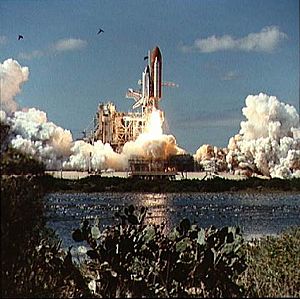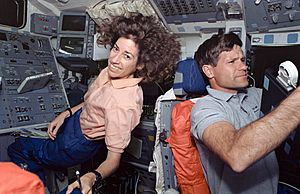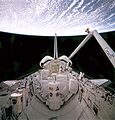STS-66 facts for kids
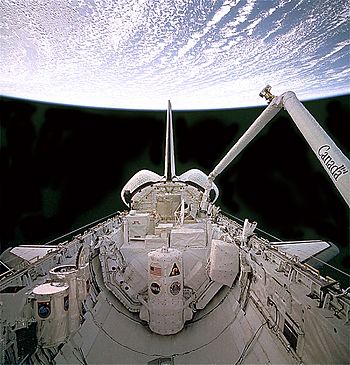
ATLAS-3 in the payload bay of Atlantis, while the Shuttle's Canadarm grapples CRISTA-SPAS
|
|
| Mission type | Research |
|---|---|
| Operator | NASA |
| Mission duration | 10 days, 22 hours, 34 minutes, 2 seconds |
| Distance travelled | 7,330,226 kilometers (4,554,791 mi) |
| Orbits completed | 174 |
| Spacecraft properties | |
| Spacecraft | Space Shuttle Atlantis |
| Payload mass | 10,544 kilograms (23,246 lb) |
| Crew | |
| Crew size | 6 |
| Members |
|
| Start of mission | |
| Launch date | 3 November 1994, 16:59:43.060 UTC |
| Launch site | Kennedy LC-39B |
| End of mission | |
| Landing date | 14 November 1994, 15:33:45 UTC |
| Landing site | Edwards Runway 22 |
| Orbital parameters | |
| Reference system | Geocentric |
| Regime | Low Earth |
| Perigee | 296 kilometres (184 mi) |
| Apogee | 310 kilometres (190 mi) |
| Inclination | 57.0 degrees |
| Period | 90.6 minutes |
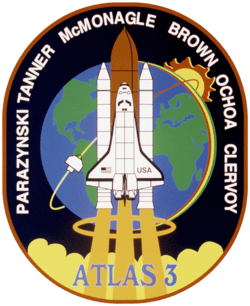 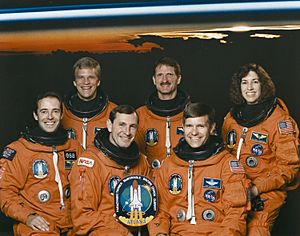 Left to right: Clervoy, Parazynski, Brown, Tanner, McMonagle, Ochoa |
|
STS-66 was a Space Shuttle program mission. It was flown by the Space Shuttle Atlantis. This mission helped scientists learn more about Earth's atmosphere and the Sun.
Atlantis launched on November 3, 1994, from Launch Pad 39-B at Kennedy Space Center in Florida. It landed back on Earth at Edwards Air Force Base in California on November 14, 1994. The mission lasted almost 11 days.
Contents
Meet the Crew of STS-66
The STS-66 mission had six astronauts on board. They worked together to complete all the science experiments.
| Position | Astronaut | |
|---|---|---|
| Commander | Third and last spaceflight |
|
| Pilot | Second spaceflight |
|
| Mission Specialist 1 | Second spaceflight |
|
| Mission Specialist 2 | First spaceflight |
|
| Mission Specialist 3 | First spaceflight |
|
| Mission Specialist 4 | First spaceflight |
|
Mission Goals and Discoveries
The main goal of STS-66 was to study Earth's atmosphere and the Sun. Scientists wanted to understand how the Sun's energy affects our planet. They also looked at how Earth's climate and environment change.
Studying Earth's Atmosphere
The mission used a special lab called the Atmospheric Laboratory for Applications and Sciences – 3 (ATLAS-03). This lab helped scientists measure the middle part of the Northern Hemisphere's atmosphere. They made these measurements in late fall. This timing was important because the Antarctic ozone hole was shrinking. Scientists could study how the ozone hole might affect other parts of the world. They also watched how the northern atmosphere changed as winter came.
CRISTA-SPAS: A German-American Project
A key part of the mission was deploying and retrieving CRISTA. This stands for Cryogenic Infrared Spectrometer Telescope for Atmosphere. CRISTA was attached to a special satellite called the Shuttle Pallet Satellite. It was designed to explore how much the atmosphere changes. Its measurements helped complete data from another satellite launched in 1991. CRISTA-SPAS was a joint project between the U.S. and Germany.
The crew worked in two teams, around the clock. This allowed them to collect a lot of data. The ATLAS-3 and CRISTA-SPAS were considered one big mission with shared science goals.
Instruments on ATLAS-3
The ATLAS-3 instruments were placed in the Shuttle's cargo bay. They included:
- Atmospheric Trace Molecule Spectroscopy (ATMOS): This instrument collected more data on gases in the atmosphere than ever before.
- Shuttle Solar Backscatter Ultraviolet Spectrometer (SSBUV): It measured ozone levels. This helped calibrate an ozone monitor on an older satellite.
- Active Cavity Radiometer Irradiance Monitor (ACRIM): This measured the Sun's total radiation very precisely. It helped calibrate a similar instrument on another satellite.
- Measurement of the Solar Constant (SOLCON): Provided by Belgium, this also measured solar radiation. It helped track changes over many years.
- Solar Spectrum Measurement (SOLSPEC): This French instrument measured the Sun's radiation based on its wavelength.
- Solar Ultraviolet Spectral Irradiance Monitor (SUSIM): It collected very precise measurements of the Sun's ultraviolet radiation.
- Millimeter Wave Atmospheric Sounder (MAS): This instrument measured water vapor, chlorine, and ozone. It worked for nine hours before a computer problem stopped it.
CRISTA-SPAS Discoveries
CRISTA-SPAS was released from the Shuttle's robotic arm on the second day. It flew about 25 to 44 miles (40 to 70 km) behind Atlantis. For over eight days, it collected data. Then, the Shuttle's arm grabbed it and brought it back.
CRISTA gathered the first global information about small changes in gases in the middle atmosphere. This data could help create better models of our atmosphere. It also helps us understand Earth's energy balance.
Another instrument on CRISTA-SPAS was MAHRSI. This measured chemicals like hydroxyl and nitric oxide. These chemicals can destroy ozone. MAHRSI created the first complete global maps of hydroxyl in the atmosphere.
Preparing for Future Missions
During the retrieval of CRISTA-SPAS, the crew tested a new way to approach spacecraft. This was important for future missions where U.S. Shuttles would dock with the Russian Mir Space Station. This new method, called the R-Bar approach, saves fuel. It also reduces the risk of contaminating the Mir station with thruster gases.
STS-66 was the last time Atlantis flew a mission by itself for over 14 years. After this, Atlantis missions were focused on docking with Mir and later the ISS. Atlantis did not fly a solo mission again until STS-125. That was the final mission to service the Hubble Space Telescope.
Images for kids


